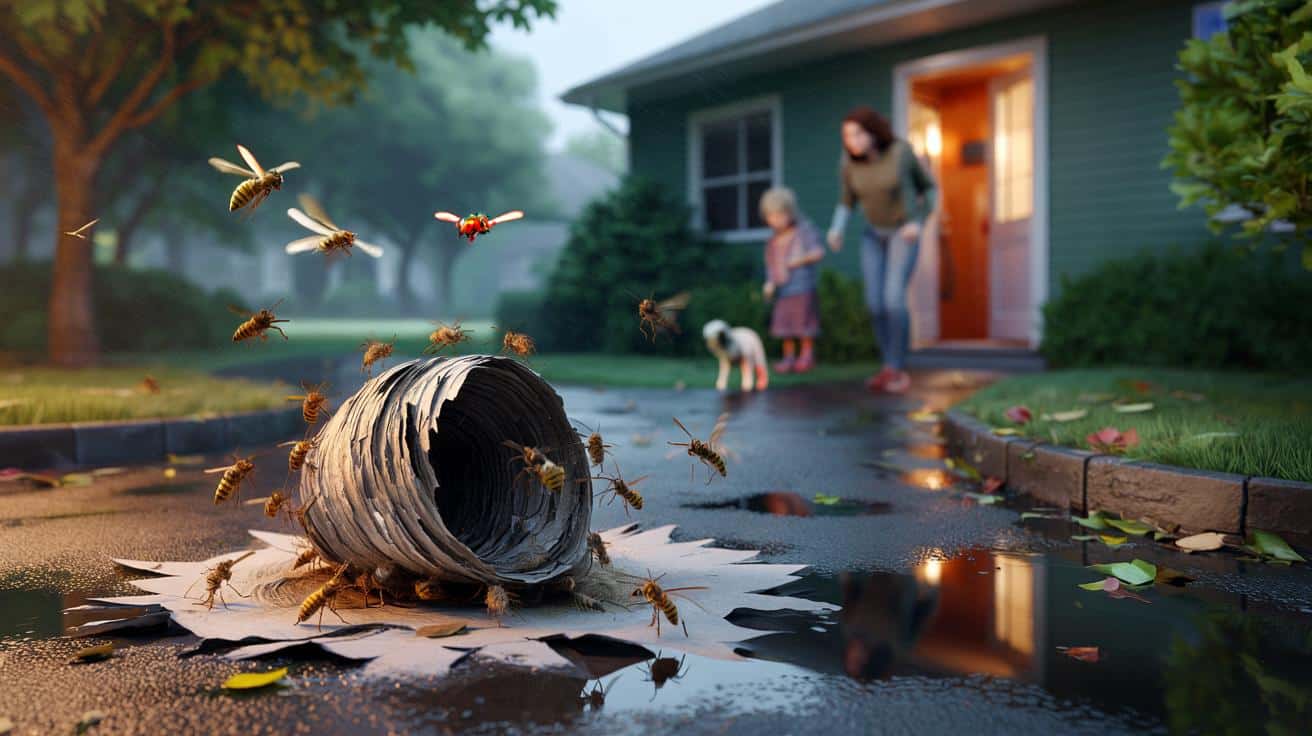Across several regions, emergency crews have logged hundreds of hornet nest incidents as storm-shaken colonies crash and rupture. Firefighters and pest specialists now juggle urgent call-outs, with residents reporting smashed papery shells, scattered combs and swarms of agitated insects around homes, schools and parks.
What the storms did to hornet nests
Strong wind loosens the fibrous anchors that hold nests to trees, soffits and sheds. Rain adds weight to the paper-like walls and soaks the brood comb. When a nest falls, the outer envelope often tears. Larvae spill out. Workers and guards pour into the air with one reflex: defend the colony.
Why nests drop and burst
- Wind shear snaps the narrow connection point between nest and branch or beam.
- Prolonged rain softens cellulose layers, weakening the structure.
- Impact fractures the comb, releasing pheromones that trigger defensive behaviour.
- Vibration from impact resembles predator attack, prompting mass stinging responses.
Most nests hang between two and ten metres high. After a fall, many break open on drives, lawns or footpaths. The danger peaks in the first hour, when surviving workers circle low and strike at movement within several metres.
Do not touch a fallen nest. Do not kick, bag, drown, burn or spray it. Keep at least 10 metres away and move people and pets indoors.
Where the danger lies for people and pets
Workers can sting repeatedly. They target faces, ankles and hands. Children and dogs often investigate the mess and get hit first. Stings around the mouth or neck carry extra risk if swelling affects breathing. People with a known allergy require immediate treatment after any sting.
Emergency services describe a familiar pattern. A nest lands near a gate. A parent tries to sweep it aside. Agitated hornets surge. Several neighbours receive multiple stings within minutes. Panic adds to the risk as people run into roads or trip on steps.
How widespread is the problem right now
Provisional figures compiled from public incident feeds and fire service logs indicate at least 312 nest-related call-outs across storm-hit counties in recent days. In some districts, daily requests for help tripled compared with earlier in the month. Most reports came from semi-urban streets with mature trees and older rooflines.
Specialists warn that secondary falls often follow the first storm front as weakened fixings give way in lighter winds. Gardeners also dislodge hidden nests while clearing debris, especially in hedges, bird boxes and loft spaces.
Expect more falls for 48 to 72 hours after high winds. Many compromised nests let go later, when gusts return or supports dry and shift.
What to do if you find a broken nest
- Get everyone indoors. Shut doors and windows. Keep pets inside for several hours.
- Note the exact location from indoors. Use a photo through glass if you must keep a record.
- Call your local council or a licensed pest controller for hornet removal. Use emergency services only if people face an immediate threat.
- Warn neighbours with a simple message or a note on shared walkways.
- Wait. Hornets calm down after dusk. Professionals prefer evening visits when activity drops.
How removal works and what professionals bring
Trained teams wear full protective suits and work at low light when hornets cluster. They dust the exposed comb with an approved insecticidal powder, then secure debris in sealed sacks. Where a nest survives the fall intact, they bag it whole. They return if activity persists.
Many services publish a response time of 24 to 48 hours, but storm surges stretch schedules. Ask for a time window and confirm price before booking. Costs vary with access, height and species. A roadside pick-up of a broken nest may cost less than a roof void treatment.
- Typical call-out window: same day to 48 hours in busy periods.
- Indicative cost range: £70 to £180 for a ground-level fallen nest; more for roof or loft work.
- Average visit length: 30 to 90 minutes, with a follow-up if needed.
Asian hornet or native hornet?
Several species build large, paper nests. The Asian hornet (Vespa velutina) spreads in parts of Europe and has appeared in the UK. The native European hornet (Vespa crabro) also occurs widely and plays a role in ecosystems. Both defend fallen nests, so treat each scene with care.
| Feature | Asian hornet | European hornet |
|---|---|---|
| Size | smaller, slimmer workers (approx. 2.5 cm) | larger, stockier workers (up to 3.5 cm) |
| Colour | mostly dark with a distinct yellow-orange band near the tail | browner with yellow head and banded abdomen |
| Typical nest sites | high in trees, sometimes in sheds or roof eaves | tree hollows, roof voids, large shrubs, outbuildings |
| Behaviour at a fallen nest | rapid defensive swarming, low flight over the ground | strong defence near the comb, wider patrol arcs |
Identification helps authorities track invasive species. Do not approach for a close look. Use a zoom photo through a window if officials request details.
First aid and when to call for help
- For a single sting, wash the area, apply a cold pack for ten minutes and elevate if possible.
- Avoid scratching. An oral antihistamine may reduce swelling.
- Call 999 if breathing becomes noisy, lips or tongue swell, or dizziness appears. These are signs of a severe reaction.
- People with prescribed adrenaline auto-injectors should use them at the first sign of systemic symptoms and call for an ambulance.
- Keep stung pets calm indoors. Contact a vet if swelling spreads or the animal seems distressed.
Why nests fail after storms
Late-season colonies reach peak size, so nests weigh more just as storms arrive. Queens push workers to expand comb to rear the last brood. Resin and saliva bind the paper, but the bond fails when soaked. Eaves vibrate in high wind, loosening attachments. Even a small crack can start a tear that grows with each gust.
How to reduce risk on your property
Prevention does not mean removing every tree. Simple habits cut exposure. Keep rooflines sound. Fit insect mesh behind vents while maintaining airflow. Check sheds and pergolas in spring for early nest starts no bigger than a golf ball, when a professional can remove them quickly. Secure bins and cover pet food to avoid attracting scouts.
- Trim branches away from roofs before storm season, using safe methods or a qualified arborist.
- Repair loose soffits and fascia boards. Hornets exploit gaps to attach nests.
- Store ladders and garden toys indoors so children do not disturb debris.
Who to contact and what to report
Local councils often coordinate pest control contractors. Fire services prioritise immediate threats to life. When you call, describe the location, access, activity level and whether the nest fell inside a school route or shared hallway. If officials ask for monitoring, report changes at set times to help them allocate teams.
What this means for pollinators and people
Hornets prey on many insects, including pests, and they also trouble bee colonies. A fallen nest in a busy street creates a direct conflict between safety and conservation. Trained teams strike a balance by removing immediate hazards while logging sightings that support wider management plans. Residents can help by reporting accurately and avoiding DIY destruction that spreads the colony or drives it into neighbouring plots.
Looking ahead as more windy spells arrive
Forecasters expect bursts of strong wind through the season. Anticipate delayed failures from nests that already cracked during the last storm. Walk gardens with care after gusty nights. Listen for a loud, steady buzzing before you open a shed or loft hatch. If you spot papery fragments or writhing comb on the ground, back away and start the safety steps.
For extra context, think about timing. Colonies wind down as temperatures drop, but warm spells can restart activity. A nest that survives one storm may fail during the next. Schools and care homes should add a simple hornet check to morning site walks on windy weeks. Sports clubs can brief volunteers so they know how to secure a pitch quickly if a nest falls near touchlines.
If you plan autumn pruning or roof work, schedule it on calm days and wear long sleeves, gloves and eye protection. Agree a signal with anyone helping so you can retreat together if you hear a surge in buzzing. These small routines reduce surprise and keep injuries low while crews work through the backlog of calls.









We had a nest drop by our gate last year—your point about the first hour being the worst rings true. We kept 10 metres back and got everyone inside. Quick Q: if a child gets multiple stings but no obvious breathing issues, is it still worth calling 999 or just monitor with antihistamine and cold packs? How long to keep pets in after dusk?